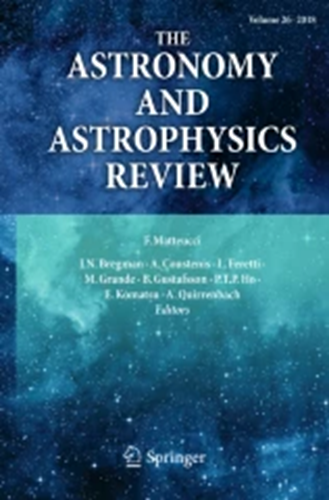The ionized heart of a molecular disk
IF 26.5
1区 物理与天体物理
Q1 ASTRONOMY & ASTROPHYSICS
引用次数: 4
Abstract
The study of hyper-compact (HC) or ultra-compact (UC) HII regions is fundamental to understanding the process of massive (> 8 M_sun) star formation. We employed Atacama Large Millimeter/submillimeter Array (ALMA) 1.4 mm Cycle 6 observations to investigate at high angular resolution (~0.050", corresponding to 330 au) the HC HII region inside molecular core A1 of the high-mass star-forming cluster G24.78+0.08. We used the H30alpha emission and different molecular lines of CH3CN and 13CH3CN to study the kinematics of the ionized and molecular gas, respectively. At the center of the HC HII region, at radii <~500 au, we observe two mutually perpendicular velocity gradients, which are directed along the axes at PA = 39 deg and PA = 133 deg, respectively. The velocity gradient directed along the axis at PA = 39 deg has an amplitude of 22 km/s mpc^(-1), which is much larger than the other's, 3 km/s mpc^(-1). We interpret these velocity gradients as rotation around, and expansion along, the axis at PA = 39 deg. We propose a scenario where the H30alpha line traces the ionized heart of a disk-jet system that drives the formation of the massive star (~20 M_sun) responsible for the HC HII region. Such a scenario is also supported by the position-velocity plots of the CH3CN and 13CH3CN lines along the axis at PA = 133 deg, which are consistent with Keplerian rotation around a 20 M_sun star. Toward the HC HII region in G24.78+0.08, the coexistence of mass infall (at radii of ~5000 au), an outer molecular disk (from ~500 au), and an inner ionized disk (<~500 au) indicates that the massive ionizing star is still actively accreting from its parental molecular core. To our knowledge, this is the first example of a molecular disk around a high-mass forming star that, while becoming internally ionized after the onset of the HII region, continues to accrete mass onto the ionizing star.分子盘的电离心脏
超致密(HC)或超致密(UC) HII区域的研究是理解大质量(> 8 M_sun)恒星形成过程的基础。我们利用阿塔卡马大型毫米/亚毫米阵列(ALMA) 1.4 mm Cycle 6的观测数据,以高角分辨率(~0.050”,对应330 au)研究了高质量恒星形成星团G24.78+0.08分子核心A1内的HC HII区域。我们分别用h30 α发射谱线和CH3CN和13CH3CN的不同分子谱线研究了电离气体和分子气体的运动学。在HC - HII区域的中心,在半径<~500au处,我们观察到两个相互垂直的速度梯度,它们分别沿PA = 39°和PA = 133°的轴线方向。在PA = 39°方向上沿轴方向的速度梯度的振幅为22km/s mpc^(-1),比另一个的3km /s mpc^(-1)要大得多。我们将这些速度梯度解释为绕着PA = 39度的轴旋转和膨胀。我们提出了一个方案,即H30alpha线跟踪磁盘射流系统的电离中心,该系统驱动了负责HC HII区域的大质量恒星(~ 20m_sun)的形成。CH3CN和13CH3CN沿轴在PA = 133°处的位置-速度图也支持这一设想,这与开普勒围绕一颗20 M_sun恒星的自转一致。在G24.78+0.08的HC - HII区域,质量落(半径为~5000 au)、外部分子盘(半径为~500au)和内部电离盘(半径<~500 au)的共存表明,大质量电离恒星仍在积极地从其母分子核心吸积。据我们所知,这是第一个围绕高质量形成恒星的分子盘的例子,在hii区域开始后,它在内部被电离,继续向电离恒星吸积质量。
本文章由计算机程序翻译,如有差异,请以英文原文为准。
求助全文
约1分钟内获得全文
求助全文
来源期刊

The Astronomy and Astrophysics Review
地学天文-天文与天体物理
CiteScore
45.00
自引率
0.80%
发文量
7
期刊介绍:
The Astronomy and Astrophysics Review is a journal that covers all areas of astronomy and astrophysics. It includes subjects related to other fields such as laboratory or particle physics, cosmic ray physics, studies in the solar system, astrobiology, instrumentation, and computational and statistical methods with specific astronomical applications. The frequency of review articles depends on the level of activity in different areas. The journal focuses on publishing review articles that are scientifically rigorous and easily comprehensible. These articles serve as a valuable resource for scientists, students, researchers, and lecturers who want to explore new or unfamiliar fields. The journal is abstracted and indexed in various databases including the Astrophysics Data System (ADS), BFI List, CNKI, CNPIEC, Current Contents/Physical, Chemical and Earth Sciences, Dimensions, EBSCO Academic Search, EI Compendex, Japanese Science and Technology, and more.
 求助内容:
求助内容: 应助结果提醒方式:
应助结果提醒方式:


